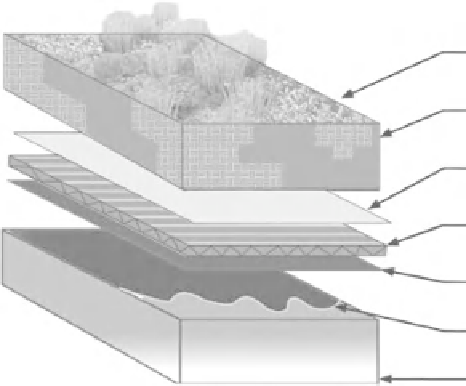Environmental Engineering Reference
In-Depth Information
All vegetated roof covers require a premium waterproofing system. Depending
on the waterproofing materials selected, a supplemental root-fast layer may be
required to protect the primary waterproofing membrane from plant roots. Insu-
lation, if included in the roof covering system, may be installed either above or
below the primary waterproofing membrane. Most vegetated roof cover systems
can be adapted to either roofing configuration. In the descriptions that follow, the
assemblies refer to the conventional configuration, in which the insulation layer
is below the primary waterproofing.
All three extensive roof cover variations can be installed with or without
irrigation. Irrigated assemblies are strongly recommended for use in arid envi-
ronments, given the region's climate and precipitation patterns. Irrigation will
ensure plant survival in the thin, porous growth medium, especially during dry
periods. In addition, dry-season irrigation allows the plants to provide the evap-
orative cooling benefits to a building when it is most needed. Some assemblies
are installed in traylike modules to facilitate installation, especially in confined
locations. These assemblies may be difficult to use with subsurface irrigation
systems.
Single-medium assemblies (Figure 7-25) are commonly used for pitched-roof
applications and for thin and lightweight installations. These systems typically
incorporate very drought-tolerant plants and utilize coarse engineered media with
high permeability. A typical profile would include the following layers:
• A waterproofing membrane
• A root barrier (optional, depending on the root-fastness of the waterproofing)
• A semirigid plastic geocomposite drain or mat (typical mats are made from
nonbiodegradable fabric or plastic foam)
Vegetation
Growth media
Separation geotextile
Geocomposite mat
Protection layer
Waterproof membrane
Roof structure
Figure 7-25
Vegetated roof system: single media.












Search WWH ::

Custom Search